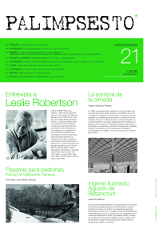On how different project mechanisms are capable of building the landscape
DOI:
https://doi.org/10.5821/palimpsesto.21.9221Keywords:
mechanisms, project, ground, limit, architecture, landscape, fiction.Abstract
Our profession maintains an agreement with the law of gravity, which, even the possible structural challenges that engineering advances allow today, cannot save the dependence of the project on the ground. This condition of architecture can be assumed, and when this occurs, a projective exercise begins, in which, on the one hand, it is possible to observe a multitude of variables that emanate from the abundant socio-physical aspects that define each specific place and how these they are interpreted by the experience lived by each architect. As, on the other hand, it is also possible to detect certain constants, which are often repeated, such as those that allow us to talk about how some projective mechanisms are aimed at founding the ground level of architecture by taking more or less distance from a line of horizon that when observed really emanates complexity. Sverre Fehn, on the subject of these questions, became aware, for example, of its thickness, of its layers and of the relationship that exists between its ends, and in fact, in its famous drawing of the fish and the bird, defined this horizon as a state limit. Years later, Steven Holl would further explain what possible positional relationships architecture could take when dialoguing with this border support. Now accepting this possible dialogue around the borders of our inescapable foundations, this article proposes to take some examples here, to further demonstrate how some of these strategies contemplated by Holl under the idea of Fehn, may also hide an interest in building the landscape. Something that can easily be noticed in the Casa Ugalde and La Ricarda on the one hand, and the Parc Cementiri de Igualada and the Parc de Pedra Tosca on the other hand. Projects that around the zero level propose us to take advantage of existing strata, build elevated podiums or even generate new elevated topographies through exceptional degrees of fiction [6], which define the individual character of each intervention, in its interest in constructing the landscape; in his interest in relating architecture to landscape and landscape to architecture.Downloads
Published
Issue
Section
License
PROTECTION AND INTELLECTUAL PROPERTY CRITERIA
Authors whose work is published in en Palimpsesto agree to the following terms:
1. The author retains the copyrights and guarantees the magazine the right to apply a Creative Commons Attribution-NonCommercial-NoDerivatives (CC BY-NC-ND), which permits others to share the work with acknowledgement of authorship.
2. The author may establish additional agreements of his or her own accord for non-exclusive distribution of the article published in the magazine (for example, in an institutional repository, or published in a book).
3. Electronic distribution of the work by the author(s) is permitted and encouraged (for example, in institutional repositories or on the author’s own website), prior to, and during the submission process, as this can generate productive exchanges, as well as earlier and greater citation of the published works (see The Effect of Open Access) (in English).
4. The author or provider of the material submitted for publication authorizes Palimpsesto to publish, with no obligation whatsoever (financial or otherwise) to the content of said material, be it in paper or digital format, or in any other medium.
5. The author or provider guarantees that he or she is the owner of the Intellectual Property rights to the contents provided, which encompasses the text and images/photographs/photographic works incorporated in the article.
6. The author or provider, exempts Palimpsesto magazine of all and any responsibility relating to violation of copyrights, thereby committing himself or herself to undertaking all efforts to assist Palimpsesto magazine in defence of any accusation, extra-judiciary, and/or judicial measures. Likewise, the author or provider will assume payment to Palimpsesto of any sum or compensation that must be paid to third parties for failure to comply with these obligations, be it the result of judicial, arbitrary or administrative decisions.
7. The submission of the texts by authors implies automatically a declaration of non plagiarism of its contents







